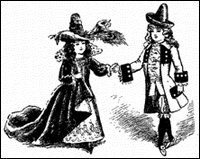Etiquette Week
Listen to the Recess! Clip
| Author | John Cech |
| Air Date | 5/19/2005 |

Etiquette Week Transcript
When I was in 6th grade, my parents sent me off for dancing classes — in a brand new suit and tie, complete with white gloves. The purpose of these excruciating events every two weeks during the winter was to teach middle school children something about proper manners and “comportment”– a subject that we were also graded on in school. Our sixth grade teacher would inspect our finger nails, behind our ears, the cleanliness and coordination of our clothes, and she would always ask us a few questions which we were expected to respond to courteously, respectfully, promptly. She also taught us about the proper form of letters, the importance of writing thank you notes, how to set a table, and how to serve a meal.
We weren’t a wealthy family; the dancing lessons were just something that seemed to happened, as sure as sunrise and sunset, in the lives of most middle school boys and girls in the town where I grew up, on the west side of Chicago. In particular, boys were generally thought of as being in need of some polishing to make them at least reasonably presentable. Plus, we’d learn the waltz, the fox-trot, the Lindy — and everything that went into social events like a dance — how to approach a possible partner and make our request; how to accept or decline graciously; how to move on to another partner after the dance was over; and, most importantly, to keep the proper distance from our partner. One of the female teachers, a very tiny woman, would make it a point to pop up between dancers, even during waltzes, to make sure of this required space.
Every generation says that they’re better behaved than the younger ones. Aristotle complained about the noisy insolence of teenagers in ancient Athens. Here in America, European visitors have been criticizing us for centuries about our sassy, unruly youth. Their own wild children had led to the first, printed codes of manners, the courtesy books that were written as early as the 12th century. These were originally intended for the children of the European aristocracy, and were meant to produce young noble men and women who had learned (presumably from the book and ever watchful adults), that it was bad manners to claw at your food or to spit it out on the table if you didn’t like it. Thank goodness, 800 years later, those practices are still considered gauche– even if our young people’s dances have twisted and frugged and moshed far, far away from those mini-cotillions of yesteryear. Yet even though the distances between waltz partners for all of us have shrunk, it’s funny, but I still can’t seem to stop asking, “May I please have this dance?”